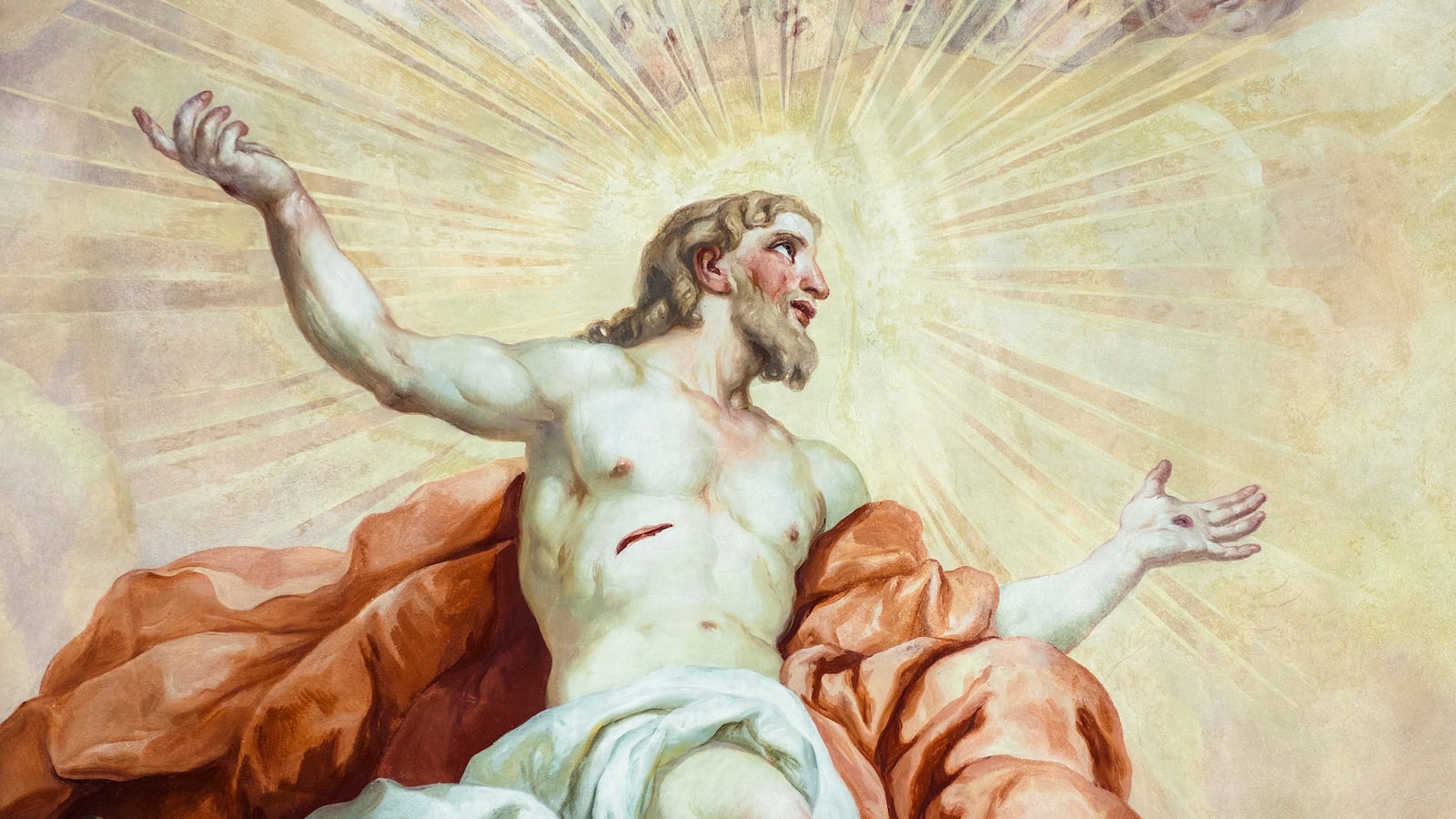Easter Sunday commemorates the resurrection of Jesus following his crucifixion on Good Friday. To many Christians what happened on that day is the heart of the Easter message and the foundation of their faith. To some non-Christians it’s a somewhat macabre folk tale invented by the traumatized disciples of Jesus. But to both groups the question: “What, if anything, did the disciples see?” is of critical importance.
The Gospel writers seem sure that something happened: each of the four Evangelists agree that when the women went to the tomb where Jesus was laid it was empty. Paul, too, tells us that Jesus was resurrected from the dead. Whether or not you believe that Jesus appeared to the disciples, it’s clear that the tradition about it is very early. But it also wasn’t that remarkable; in the ancient world, unlike today, it was fairly common to have an encounter with one’s loved one after their death. As Dr. Meghan Henning, an assistant professor of Christian origins at the University of Dayton, told me, “In the ancient world if someone told you they saw their dead mother you would reply ‘Cool, what did she say?’” There was a broad consensus that you might see your loved ones, but that didn’t mean that they had been resurrected or that they were even that special.
After all, just like in modern science fiction and horror, there was a whole host of ancient supernatural and ghostly figures in the ancient world. What if Jesus was just one of them? You can sense the anxiety about this in the Gospels of Luke and John. In Luke 24:39 Jesus displays his “hands and feet” to the disciples as proof that he isn’t a “spirit” or ghost. John uses Thomas to linger over the contours of the resurrected body. Thomas was evidently missing at the earlier appearance and famously declares, according to the NRSV translation, “Unless I see the mark of the nails in his hands, and put my finger in the mark of the nails and my hand in his side, I will not believe” (John 20:25). The ambiguity of the language yields a variety of possible interpretations. What do the “marks of the nails” look like? The dominant interpretation of this scene is one in which Jesus is still openly wounded and Thomas demands to insert his finger into Jesus’s hand and side. That idea is reinforced by crucifixes and sculpture that highlight the wounds that Jesus received during the crucifixion. The rich legacy of medieval artwork has led us to believe that we can see through the holes in Jesus’s hands but the phrase “marks of the nails” is much more ambiguous and peculiar than that.
In my new book, Divine Bodies: Resurrecting Perfection in the New Testament and Early Christianity, I investigate what the Bible actually says about the resurrected body of Jesus. Reading this passage in John it’s clear that Thomas expects to touch the body of Jesus and see if it yields to his hand (although we never find out if he actually does), but nothing about the Greek text here insists that his touch will be penetrative rather than probative. Grammatically, it is equally acceptable to see Thomas as desiring to place his fingers on Jesus’ body rather than—more suggestively—in it. The Greek word for marks – “typoi” – doesn’t mean wound. It refers to a mold or shape on which other things were modeled and can also refer to the effect of a blow or pressure. The word was sometimes used to describe the impressions of images that imprinted themselves on the eye in the act of seeing, but it was commonly used to describe the impression left by a horse’s foot, the uneven surface produced by the stamping of seals, the indentations produced in engraving, and the mint marks made by the process of striking coins. In other words, “marks” could be either outlines to be copied or deep impressions left by the application of pressure. Where “marks” are the result of pressure, they are uneven impressions on an otherwise smooth surface. This would seem to be a good description of a scar or a scab: the bump you encounter as you move your finger over otherwise smooth skin. There’s even a passage in the writings of the first-century Jewish philosopher Philo in which he uses the word to refer to a scar (Laws 1.103).
To my knowledge there are actually no instances in which it is used to describe a “through and through” puncture. When Thomas says he wants to place his finger into the marks of the nails, he might actually mean that he wants to place his finger on or in the creases of a healing or scarred wound, rather than into open holes. Interestingly, if we look at ancient medical writers, it’s clear that they also think that bodies start to—forgive me—scab over after several days. The way we have imagined this scene is mistaken.
Why does it matter if he is bleeding or scarred? Well, scars communicate something important about the very nature of Jesus’s resurrected body. Some scholars, like Bishop N. T. Wright, claim that the presence of wounds and the tangible physicality of Jesus’s body demonstrate that he is a live person and not a kind of ghost. And that, moreover, he is the first person to be permanently resurrected in human history. The problem is, as Professor Gregory Riley has written in Resurrection Reconsidered, this isn’t strictly speaking true. To be sure, there are kinds of ghosts—like that of Odysseus’s mother in Homer’s Odyssey—whose soul or “psyche” slips through his hands “like vapor,” but there were other kinds of supernatural entities who could easily be touched. In fact, they might even like it. It’s not fatuous to suggest that Jesus was a zombie; reanimated corpses were a common phenomenon in the ancient world. In a book of fantastical stories by the second-century writer Phlegon, we learn about a young girl named Philinnion who emerges at night from her family tomb in order to liaise with a male house guest. During her periods of reanimation, which last anywhere from minutes to days, she eats, drinks, and has sexual intercourse. Just as we would not suggest that the Night King resurrects people so much as reanimates corpses, we wouldn’t say that Philinnion is actually alive. Intangibility might be a proof of ghostliness, but the ability to touch a person is no assurance that he or she is actually alive.
In the same way, having wounds doesn’t necessarily prove that Jesus is alive either. A number of ghosts or “shades” of the dead preserve the marks of their death in their form. In the Aeneid, for example, Virgil describes Dido’s wounds as “still fresh” in the underworld. Just because a dead person appears to you and seems to be bleeding doesn’t automatically mean that they have been resurrected from the dead.
This is where the “marks” on Jesus’ body become important. Wound healing is not possible in corpses, even ambulatory ones. They knew this even in the Roman world: the second-century Roman doctor Galen is clear that blood does not flow without heat and that both are required for new flesh to be supplied to serious wounds like these. Nor do physically touchable zombies and ethereal shades exhibit signs of healing in the afterlife. As a rebuttal to the potential anti-resurrection objection that what the disciples saw was a mere apparition, not a truly resurrected body, the presence of visible wounds is not, and would not have been, particularly convincing. By contrast, the scarring of Jesus’s body proves, in ways that having open wounds does not, that the very same Jesus that was crucified is now actually alive.
Now of course none of this means that the resurrection actually happened: that’s a question of individual belief. But one thing is for sure: long before zombies became a phenomenon in pop culture, the Evangelists were forcefully arguing that Jesus wasn’t one. Unfortunately, the history of translation and interpretation has hidden their meaning.
Candida Moss is a Daily Beast columnist and the author of the new book Divine Bodies: Resurrecting Perfection in the New Testament and Early Christianity.







